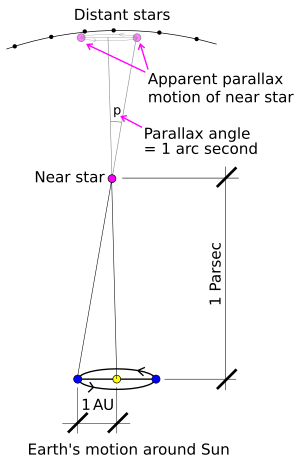Parsec facts for kids
A parsec is a special way to measure really, really big distances in space. Imagine trying to measure how far away a star is! A parsec helps astronomers do just that. It's about 3.26 light-years long. That's almost 31 trillion kilometers (or 19 trillion miles)!
Quick facts for kids Parsec |
|
|---|---|

A parsec is the distance from the Sun to an astronomical object which has a parallax angle of one arcsecond. (the diagram is not to scale).
|
|
| General information | |
| Unit system | astronomical units |
| Unit of | length |
| Symbol | pc |
| Conversions | |
| 1 pc in ... | ... is equal to ... |
| SI units | 3.0857×1016 m |
| imperial & US units | 1.9174×1013 mi |
| other astronomical | 2.0626×105 AU |
| units | 3.26156 ly |
Contents
What is a Parsec?
A parsec is a unit of distance used by astronomers. It is defined by something called parallax. If a star appears to shift by one arcsecond (a tiny angle) when we look at it from different sides of Earth's orbit, then that star is one parsec away.
Distances that are smaller than a parsec usually mean objects are within the same star system. For example, planets in our own Solar System are much closer than one parsec.
Understanding Parallax
Surveying gives us a good way to understand parallax. Go outside and look at something far away. Hold your hand out with one finger pointing up. Close one eye. Line up your finger so it covers the distant object.
Now, close that eye and open the other one without moving your arm. Your finger will seem to have moved! This apparent shift is called parallax. If you then move your finger to block the object with your other eye, the two positions of your finger can help you figure out how far away the object is.
How Astronomers Use Parallax
Astronomers use this same idea to measure how far away stars are. As Earth travels around the Sun, our view of nearby stars changes slightly. This small shift in a star's position against the background of much more distant stars is its parallax.
The bigger the shift, the closer the star is. By measuring this tiny angle, astronomers can use trigonometry (a type of math) to calculate the star's distance in parsecs.
Looking into the Past
A parsec is such a huge distance that if you could see that far, you would actually be looking into the past! This is because light takes time to travel.
It takes 3.26 years for light to travel one parsec. So, when we see a star that is one parsec away, we are seeing it as it looked 3.26 years ago. The light we see now left that star over three years ago!
Images for kids
-
This image from the Hubble Space Telescope shows a powerful jet of energy shooting out from the center of a galaxy called M87. This jet is thought to be about 1.5 kiloparsecs (1,500 parsecs) long.
See also
 In Spanish: Pársec para niños
In Spanish: Pársec para niños


